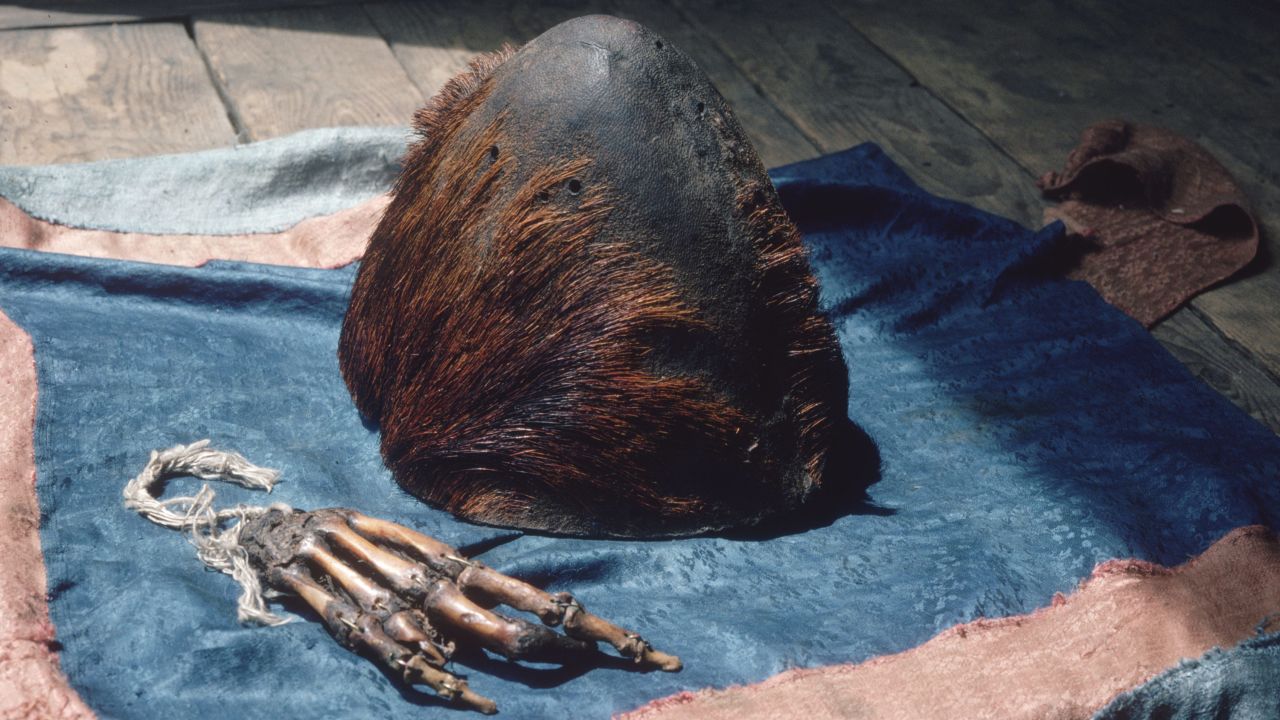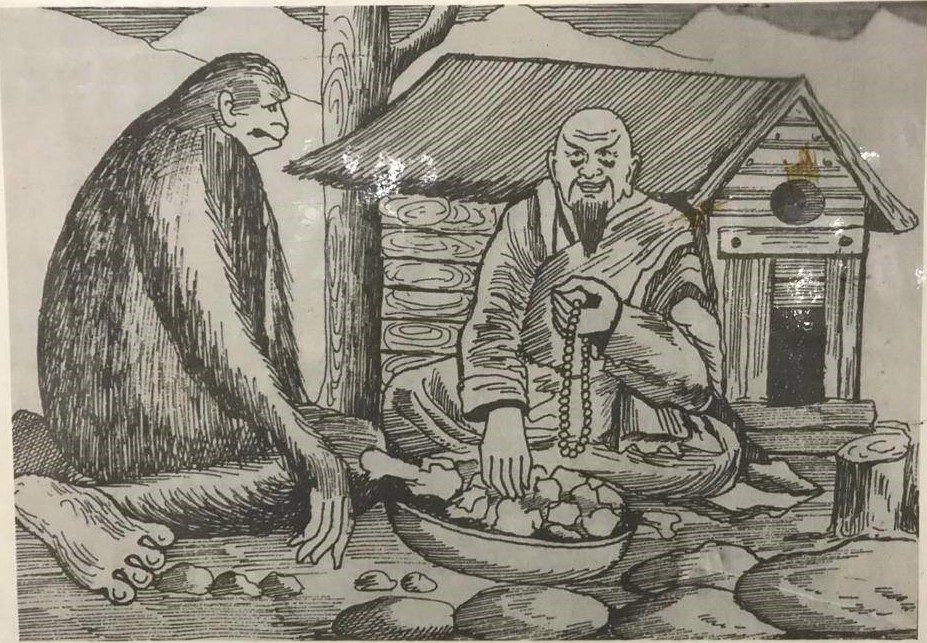Mystery of Yeti Footprints Indian Army Major Sushant Singh And Sherpa Guide
Mystery of Yeti Footprints Indian Army Major Sushant Singh And Sherpa Guide: The above photo was taken almost 70 years ago in 1951. In 1951, many mountaineers set out on a journey to find out which paths could be taken to scale Mount Everest.
In this group was Edmund Hillary, who, along with Tenzing Norgay, became the first human being to conquer the heights of Mount Everest.
And this person is Eric Shipton, who took the first photo of the footprints of Yeti. Along with his partner Dr. Michael Ward, he had seen strange footprints in the Menloong Basin of Nepal. He didn’t have any tape to measure these footprints.
So, he used an ice pick to show how big the footprint was and took a photo of it. When this photo was published, many people around the world started talking about it. Newspapers, science journals, and popular magazines started discussions on this photo.
Many people went to the Himalayas to check whether the animal to which the footprints belong is even real or not? Even the Nepali government gave people licenses to hunt Yeti.
The US government issued a notice where it stated the things one should keep in mind if one sets out in search of Yeti, Many people were interested in this story of the Yeti. But is the Yeti real or fake? What is its history? This is what I want to tell you about it in this article.
History Of Yeti:
Major Sushant Singh of the Indian Army. He was on an expedition in the Makalu area in the Himalayas. He said he saw such big footprints that could not belong to any human. When Sushant asked his sherpa guide about it, the guide said that these footprints are that of a wild man who lives in the snowy areas.
Even if there has been a discussion for years across the world about whether Yeti is real or not, the sherpas have no confusion about it. Yeti has been a part of their culture for centuries.
Sherpa Folklore
The word “Yeti” came from the Tibetan sherpa language in it, there was a word, YETE, which means ‘rock animal’. You’ll get written records about Yeti as far back as the 12th century, around 850 years ago. According to a Tibetan religious text, by the name of Manikabum, Tibet used to be a huge lake.
When the lake began to dry up, new forests, animals, and mountains emerged. The Tibetan people were born in one of these mountains. In these mountains lived Sinmo, a creature that was an incarnation of the Buddhist goddess, Drolma. This creature met a monkey, who was an incarnation of the Buddhist God, Chenrezig.
They bore 6 off-springs-who were both human and monkey. It’s believed that these 6 children had hair all over their bodies and also had a tail. These 6 children gave rise to 6 different Tibetan groups. Over the years, they became less like monkeys, and more like humans.
Eventually, modern Tibetan people were born. The Tibetans believe that some of their ancestors never became humans. They remained wild. And they were called Yeti.
Tibetans believe that Yeti are not like other animals. They are somewhat like humans, but not completely human. They are animals that don’t sleep at night, live in high altitudes, and stay away from humans. You’ll find many photos of such animals in Buddhist temples and in books.
You’ll also find such animals on the walls of many monasteries in Tibet and Nepal. Some stories say that Yeti is a very calm animal. While some stories say that they are very dangerous.
According to a Tibetan story, a Buddhist priest encountered an injured Yeti. When the priest helped the Yeti, the Yeti placed a dead tiger’s body in front of him to express his thankfulness. Other stories say that many times, humans offered alcohol to the Yeti so that the Yetis would fight among themselves and kill each other.
According to Tibetan stories, Yeti is not only males but also females. According to one story, a female Yeti captured a man and bore two children with him. When the man tried to run away with their son, the Yeti killed the man and ate their child. There are many such stories.
Even if people like us found out about Yeti stories only a few years ago, such stories have been narrated among the Sherpa people for many years. It’s not that the Yeti stories are present only in the Tibetan culture.
Read More: Mahabharat Barbarik – Khatushyam Temple Mystery
The Abominable Snowman
The question is whether the Yeti is real or not. A lot of evidence has been presented in this regard. For example, the above picture is from 1951. But 30 years ago the photograph was taken, and an expedition had taken place back then, Charles Howard Burry had noticed footprints in the snow that he could not understand the origin of.
He noticed this footprint while. Many stories have been created due to the Yeti mystery Add to this several books, video games, and movies as well.
The Abominable Snowman! -The Tibetans call them Yeti! Now the question is: whether we can or cannot believe the evidence that has been presented with regard to the Yeti. This evidence is of two kinds: First, there are stories. Let’s talk about 1974. Blab Kodoma, the wife of Nepali Sherpa, was found wounded near a river.
When she regained consciousness, she told people that the Yeti threw her into the river. But it’s difficult to verify such things. So we’ll concentrate on the other types of evidence. And that is footprints, hands, or hair. Let’s talk about footprints first. Many mountaineers have taken several photographs in which they claimed that the footprints belong to the Yeti.
For example, a picture from 1951, Or a photograph taken by the Indian army 3 years ago. So are these all footprints of the Yeti? If you were to believe the scientists and experts, then NO.
Evidence
In 1921, when Charles Howard Burry saw weird footprints, he said that he himself didn’t believe that these footprints belonged to a wild man. In fact, he told a journalist that these footprints belonged to a wolf. But there was no spice in this story.
So the journalist published that these footprints belonged to an abominable snowman. But what about this picture from 1951? These footprints don’t look like that of a wolf. Dr. Michael Ward said that according to him, these footprints belong to a human.
In 1999, he wrote that these footprints belong to a Tibetan whose feet were a bit strange. Now if these footprints belong to a human, then who stays barefoot in such cold weather?
Dr. Michael Ward also gave an explanation about this. He said that in his own experience, he has met many tribes in Bhutan and Nepal who actually roam barefoot in the snow. So do these footprints belong to a human?
Scientists say no. In 1955, many experts said that these footprints belonged to a bear. Legendary mountaineer, Reinhold Messner, who was the first man to scale the 14 highest peaks of the world without oxygen, believed in the same thing. Now, researcher Daniel C. Taylor, who has been researching about Yeti for many years, and has also written a book, also believes in this.
The obvious explanation for this footprint was that it was some known animal that was making the footprint rather than what everybody wanted it to be.”Now let’s talk about the other evidence.
Look at this photograph. This is the scalp and hand of a Yeti which you can find in a Nepalese monastery. Now, how did this scalp and hand reach Nepal’s monastery? That is a very interesting story that should be a Bollywood movie in my opinion.
Pangboche Gompa
Let’s start from the beginning. According to the Tibetan text, there was an Indian Buddhist monk named Sangwa Dorje, who had gone to Nepal to meditate in a cave. He said that a very peaceful Yeti brought food, water, and oil for him. When this Yeti died, Sangwa Dorje kept the scalp and hand of the Yeti and placed them in Pangboche Gompa, a monastery that he built in 1667.
Then in 1957, an American man came to research Yeti. His name was Tom Slick. But he couldn’t find the Yeti. He got injured and asked two brothers to search for the Yeti. These brothers were Peter and Brian. While searching, Peter found that the Yeti’s hands and scalp were in the Pangboche monastery. Now listen to this. Peter smuggled one finger off of the Yeti’s hand along with a Hollywood superstar, James Stewart, who had come to Calcutta at that time with his wife Gloria.
Stewart told his wife to keep the finger of the Yeti in her undergarments so that Indian Customs officials would not suspect them. And so, the finger of the Yeti reached London. In London, a scientist, Osman Hill, was given the responsibility to determine if the finger belonged to the Yeti or not. Osman Hill concluded that the finger was not that of a Yeti, Rather, it was that of a human.
And then, the finger disappeared. The finger disappeared in 1991. And 20 years later, a BBC documentary crew got to know about this finger. They found this finger in the Royal College of Surgeons’ Hunterian Museum, London. The documentary crew also got permission to conduct a DNA test on this finger.
Dr. Rob Jones, a senior scientist at the Zoological Society of Scotland, said that the finger was that of a human. The finger was of a human, but what about the scalp?
In 1960, Edmund Hillary, who had climbed Mount Everest, said that along with some scientists, he’d try to find out who the scalp belonged to, And the scientists found out that even the scalp did not belong to a Yeti. The scalp was that of a serow, a Himalayan animal similar to a goat.
So, the footprints were of a bear, the hand was of a human, and the scalp was of a serow. Now, let’s come to the last piece of evidence. Brian Sykes, an Oxford geneticist 2013, he challenged the entire world by asking any person in the world to bring him the hair, teeth, or skin of a Yeti Because of this, he got 57 samples, out of which, he chose 36 for DNA testing.
These samples were then compared to the genes of the other animals unfortunately, most of the samples belonged to animals like crows, horses, or bears. But two of these samples were interesting. These samples were from Ladakh and Bhutan. These samples matched with a polar bear who was found on earth around 6.5 lakh years ago! Because of this, Brian Sykes said that the Yeti is a hybrid of the polar bear and brown bear.
When other scientists analyzed the same data, two mysterious samples from Ladakh and Bhutan were actually samples of a subspecies of the Brown bear. In 2017, another team of scientists analyzed the body parts of the Yeti: For example, bones, teeth, skin, and hair. These samples were collected from the caves and monasteries in the Himalayas and Tibet.
They collected 9 samples. Of the nine yeti samples, eight were from Asian black bears, Himalayan brown bears, or Tibetan brown bears. The 9th sample was of a dog.
Conclusion
Listening to all this might give rise to a question in your mind: Despite so much evidence against the existence of the Yeti, why is there so much discussion on the Yeti even today?
Why are so many videos being made on it and why are they getting lakhs of views? According to Shiv Dakaal, who has written a book on this topic, says that the Yeti stories probably became popular because the parents wanted to teach a lesson to their children that kids wouldn’t wander far away and always stay close to their families according to others, such stories give us a lesson: A lesson that knowledge is gained not by degrees. Instead, it is gained through curiosity and bravery.
According to Daniel C Taylor, people believe in the Yeti as a symbol of the human connection to the wild. Thus, we want to believe in such evidence. Despite the fact that evidence does not support the existence of the Yeti. Irrespective of whether it is male or female I don’t know what its gender is!
I have written this article, but I know that stories like that of the Yeti would not cease to exist in our society there are two reasons for that-First: You can never ever prove that the Yeti does not exist. There is a line in English- ‘Absence of evidence is not evidence of absence.
If you do not have proof about something, it does not mean that the thing does not exist this argument can also be put forward for aliens. But we can never prove that aliens do not exist at all that holds true for the Yeti, the aliens, flying elephants as well as a five-headed monkey!
That is the first reason. The second reason is Major Sushant Singh who saw footprints in the Himalayas.
Hope you liked this.















